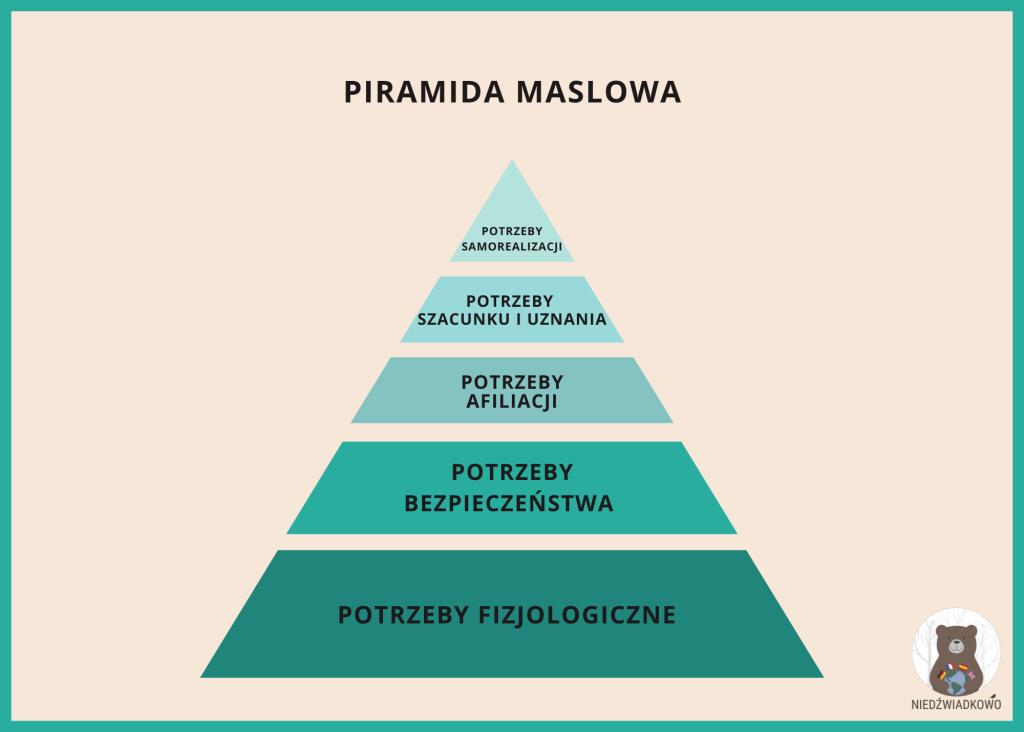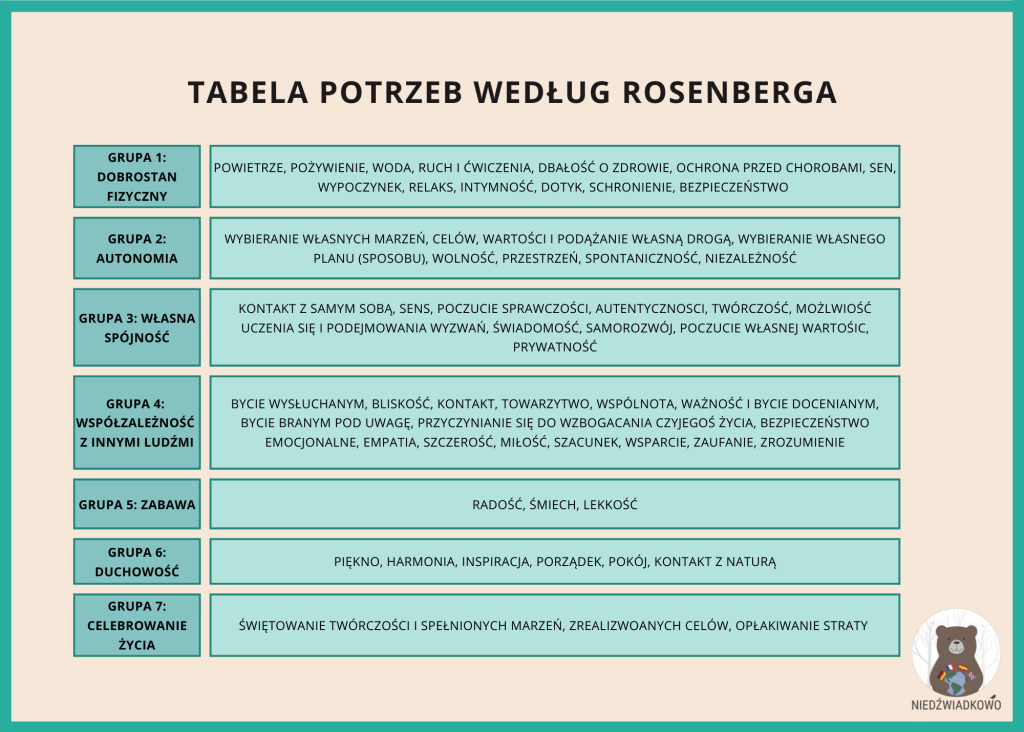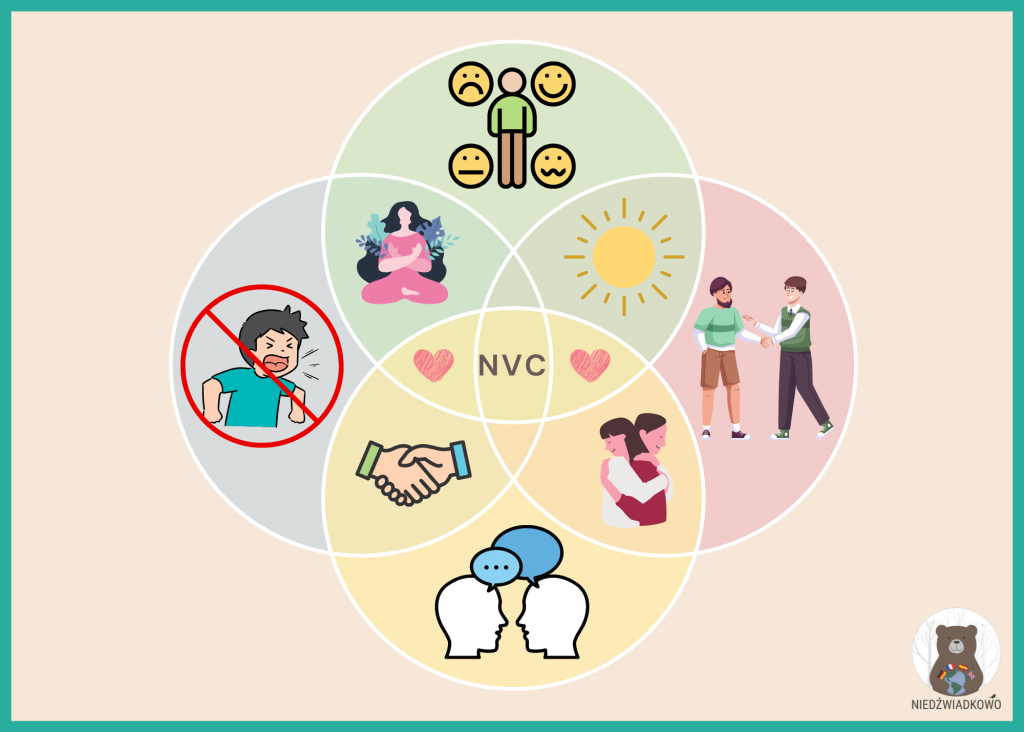Po emisji wywiadu, który nagraliśmy razem z Michałem Poklętowskim dla ESKA ROCK (link: https://youtu.be/1KX1XvQ6–w) pojawiło się sporo pytań o często wspominaną przeze mnie konieczność CONVERSATION with the Child, which I considered a recipe for solving many educational problems.
Therefore, I decided to expand the topic, tell more about how proper communication with the Larger and Smaller should proceed. As it is one of the most important elements of working with both the Youngest and Adults (after all, Niedźwiadkowo is a place of professional fulfillment of a large number of people and we also have to talk to each other, and the children are watching us!) it should come as no surprise to anyone that the main method we use is the famous Non-Violence Communication.
Many items have been written about styles and ways of communication, but in a series of these articles I would like to focus on the following issues:
- What is NVC, where did it come from, what are its goals and benefits from its use?
- Accelerated course on NVC implementation in every home – practical tips.
- How to teach your child to use both NVC and negotiation style in a conscious way? (WARNING! The risk that we can thus create a small, good, but at the same time sensitive Manager at home ;))
I devote this article entirely to the first point. I hope that the unconvinced will be persuaded to implement this extremely peaceful method of communication in their Family. 🙂 I guarantee it's worth it!
Genesis
The concept of NCV was initiated by the American psychologist Marschall B. Rosenberg. After obtaining a doctorate in clinical psychology and many years of practice, he decided to devote himself to the idea of resolving conflicts in a peaceful manner. For over 40 years, he has taught how to improve mutual communication. He worked as a mediator in areas of armed conflict around the world, in ghettos and prisons.
Of Jewish origin (the Rosenbergs were non-practicing), Marshall experienced violence and unpleasantness at school on a frequent basis during his adolescence. He also observed how any difference could provoke dangerous reactions from the environment. He wondered why you could be hated because of a trait you couldn't control.
In contrast to the experience from school, it is important that young Rosenberg experienced at the same time in the family home a great deal of goodness and empathy towards others. His loved ones take care of family members with love and devotion. Looking at his abbreviated biography, it can be said that he felt a vocation to spread knowledge about communication.
Out of a desire to develop his own process that would enable people to take a constructive approach to meeting their needs, as well as to lead a life full of meaning, Rosenberg creates a prototype in the late 60s NVC. In the following years, Marshall wrote down and developed his model.
MAGIC SEVEN
Rosenberg sat in opposition to the well-known Maslow Pyramid (for the forgetful, the graphic below). He argued that needs are not divided into "lower" and "higher", but into parallel ones. This means that you can experience at the same time, for example, a feeling of love and mourn the loss, be hungry and have a great time. This model is more slow, assumes a place for everything and allows you to create an image that is colorful and has different shapes, that is... is life 🙂


WHY THIS THEORY?
And well, to understand that communication is used to meet the needs: ours or someone (including the Child, of course!) and should be supported WILLINGNESS TO MAKE CONTACT INTERPERSONAL. Usually, we want to get closer to each other, get along, arrange something, arrange, find out. Language serves us here as a tool to take care of NEEDS, but also reflects what we think. Conscious conversation is therefore a consequence of the path STIMULUS – NEED – LAUNCH – REACTION. In order for this reaction at the very end to be correct (i.e. not aggressive or negative, incorrect), it is worth taking a few steps back and looking at what need it is motivated by (what is it about me, the Child, the Family?). Such a line of reasoning will help to avoid hurting oneself (the child is most often unconsciously hurt by words).
BENEFITS
In my opinion, the NVC methodology is the quintessence of mature communication, which is based on equality, but does not exclude the authority of an adult. It has nothing to do with "dissolution" or "stress-free upbringing." On the contrary! At first, it can bring a lot of stress 😉, because before we learn to "speak again" (mainly) the child will test us. Over time, however, everyone should get used to the fact that we talk in a different way, everyone will be heard and is relevant. Because it is, right? 🙂
Additionally NVC it provides a fantastic foundation for building deeper relationships and getting to know each other. Let's agree once and for all – if our Child, no matter at what age, does not want to talk to us (because he is not taught to do so), we will not be an authority for him (even if we enforce some tasks and it will seem to us that we have achieved the goal).
Using NVC on a daily basis, you can notice that:
- we argue less
- we do not use aggression (neither active nor passive)
- Children begin to come to us with their problems and talk about themselves (and the Younger ones know from the beginning that they have support in the Adult)
- we build home security, a place that is well associated and we want to come back to it
- we actively participate in the life of every member of the Family
- we meet our own and others' needs without much effort
- we regain time (previously spent waiting for someone to finally do something)
TO SUM UP
Non-Violent Communication is a method in which we take responsibility for OURSELVES and our feelings, and do not put it on others. We take into account the needs of everyone. At first it may seem extremely artificial, but you can get to practice with it.
We must also tell ourselves one thing: not everyone will grasp the subject NVC, they will be aggressive, they will not want to, BUT if for some reason we share life (because even if we raise a child together) it is worth getting along and choosing a common communication front. It's just going to be easier.
Cons: a person stops throwing himself in conversations like a 😉 carp before Christmas Eve, at some point we can not throw all the anger and regret on another person (which often happens in quarrels, because SOMEONE DID NOT DO SOMETHING / DID NOT GIVE SOMETHING), we begin to take responsibility for ourselves and what is happening around us.
The decision whether we are ready for such an arrangement as usual is up to us alone. 🙂
HOMEWORK
Over the next two weeks, observe how you address your loved ones. What sentences do you use? Are there magic words? Do you inform about your well-being? Do you ask, apologize, thank you? It is recommended to quote 😉

AUTHOR: NICOLE CIEPLIK, DIRECTOR /NIEDZWIADKOWO/


